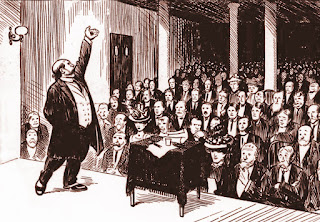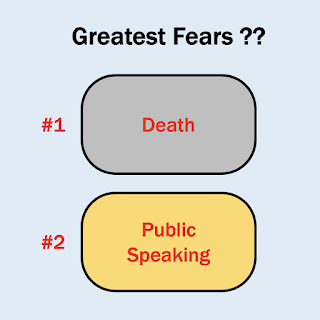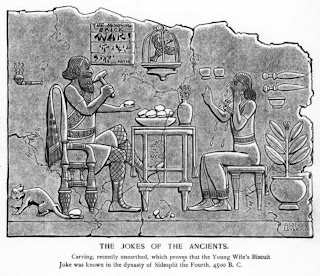Not really. But I found nine articles and four books with
that claim. When I looked for what they had to document it, I came up empty. None
had any details and references or links to the surveys or studies they mentioned
(when and where they were done, or even what percentages had those two fears).
An article by Anita Chaudhuri in the February 5, 2006 Sunday
Times titled Everything is possible claimed:
“People often list speaking in public as their biggest fear,
second only to death.”
Sylvia McLaren-Tishler’s 2008 book Public Speaking for the Terrified!
Pocket Tips says:
“Hello and welcome to Public Speaking for the Terrified! Did
you know that public speaking ranks as the number one human fear, second only
to death!”
A second article by Barbara Quint in the September/October 2014
issue of Online Searcher titled
Playing to your strengths claimed:
“While studies have shown that a majority of people
consider public speaking a horror second only
to death—and some even push death down into the Miss Congeniality slot— there are
still people like a cousin of mine.”
A third article by Cameron Kahler at Business 2 Community on
October 21, 2014 titled The 5 Cs' of Powerful Presentations stated that:
“In fact public speaking is the second most feared thing
after death!”
A 2014 book by Sharon Lowe titled The Mind Makeover: The
answers to becoming the best you yet says:
“Researchers tell us that public speaking is second on the
list of what people fear most (number one is death).”
A fourth article by Amy Lemire at LinkedIn Pulse on March
13, 2017 titled What some fear more than death: public speaking: 5 of my top 10
‘world class’ presentation skills tips states that:
“It has often been said that some people list 'death' as
their #1 fear, and their #2 fear is public speaking.”
The fifth paragraph in a fifth article by Ben James at LinkedIn
Pulse on November 18, 2019 titled How to improve your public speaking
preparation claimed:
“Research tells us that public speaking is the second
biggest fear for the general public, second only to death!”
Chapter 1 in a 2020 book by Amy Lemire Simatos titled From
Zero to Speaker Hero: how to achieve fame, fortune, and fun as a speaker and
presenter begins:
“What is your top fear? I ask this question at every
presentation skills workshop I deliver within the first five minutes. As I add
the audience responses to the flipchart, I hear laughter. Some of it is the
nervous type when you are feeling awkward. Other participants say their
responses amidst the others. It always seems to be the same responses, or a
variation in some way.
As I write the responses they come up as:
#1 – The fear of death
#2 – The fear of public speaking
The other responses commonly are: heights, snakes, and spiders.
I inform the audience they are right according to recent studies. The fear of
public speaking is ranked #2 of our greatest fears, and the fear of death is
#1. Yes, according to most public surveys, people fear death almost as much as
they fear public speaking. To this day, I have never had anyone in my audience
challenge me on that conclusion.”
A sixth article by Julie Bobell at Speak with Purpose on November
17, 2020 titled Being able to speak in front of others is a learned skill
states that:
“It is true that public speaking is the second most feared
phobia, after the fear of death.”
Chapter 5 of a 2021 book by Michael D. Butler titled Finding
the Speaker’s Edge has the heading:
“The Second-Most Feared Thing in the World is Public Speaking,
Surpassed Only by the Fear of Death.”
A seventh article by Sue Ludwig at the NANT Blog from the National
Association of Neonatal Therapists on June 12, 2021 titled The secret sauce for
public speaking: there’s only one you says:
“I was understandably nervous the first time I spoke in
front of an audience. There’s a reason the fear of public speaking is second
only to death.”
The first sentence in an eighth article by Michael O’Keefe
on November 28, 2021 titled Public speaking for teachers states that:
“Public speaking, it is commonly said, is one of the most
pervasive fears (in some surveys, second only to death).”
A ninth article by Michael Pollick at Wisegeek on January
27, 2022 titled What Are Some Public Speaking Tips? begins:
“For many people, only the fear of death trumps the fear of
public speaking.”
What’s going on here? Why do people think fear of death is
#1 and fear of public speaking is #2? I am unaware of any recent studies (or
surveys) that list fear of death at #1 and fear of public speaking at #2. In
his Seinfeld TV show on May 20, 1993 Jerry had told this joke:
“…. According to most studies, people’s number-one fear
is public speaking. Number two is death. Death is number two! Now this means to
the average person, if you have to go to a funeral, you’re better off in the
casket than doing the eulogy.”
Some didn’t realize that he was joking, and had changed
death to #2 from the #7 in a survey reported in the 1977 Book of Lists.
I think the authors of those dozen articles or books
mentioned above were confused. They had flipped the joke over to claim that
death is #1 and public speaking is #2. That’s what happens when you don’t do
careful research. Back on July 30, 2012 I blogged about Is fear of public
speaking the greatest fear in the entire galaxy? In that post I mentioned
fifteen surveys. Public speaking was first in five. Death never came first –
the highest it came was third.
The headstand Y image was adapted from a print at Wikimedia
Commons.





















